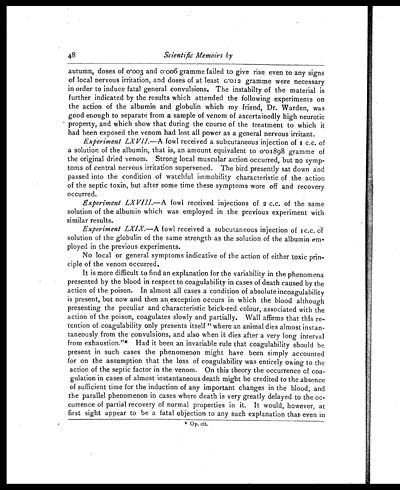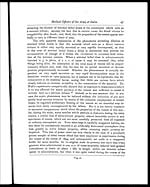Medicine - Institutions > Army health reports and medical documents > Scientific memoirs by medical officers of the Army of India > Part IX, 1895 > 1 - Physiological action of snake-venom
(54) Page 48
Download files
Individual page:
Thumbnail gallery: Grid view | List view

48
Scientific Memoirs by
autumn, doses of 0.003 and 0.006 gramme failed to give rise even to any signs
of local nervous irritation, and doses of at least 0.012 gramme were necessary
in order to induce fatal general convulsions. The instabilty of the material is
further indicated by the results which attended the following experiments on
the action of the albumin and globulin which my friend, Dr. Warden, was
good enough to separate from a sample of venom of ascertainedly high neurotic
property, and which show that during the course of the treatment to which it
had been exposed the venom had lost all power as a general nervous irritant.
Experiment LXVII. —A fowl received a subcutaneous injection of 1 c.c. of
a solution of the albumin, that is, an amount equivalent to 0.01898 gramme of
the original dried venom. Strong local muscular action occurred, but no symp-
toms of central nervous irritation supervened. The bird presently sat down and
passed into the condition of watchful immobility characteristic of the action
of the septic toxin, but after some time these symptoms wore off and recovery
occurred.
Experiment LXVIII. —A fowl received injections of 2 c.c. of the same
solution of the albumin which was employed in the previous experiment with
similar results.
Experiment LXIX. —A fowl received a subcutaneous injection of 1c.c. of
solution of the globulin of the same strength as the solution of the albumin em-
ployed in the previous experiments.
No local or general symptoms indicative of the action of either toxic prin-
ciple of the venom occurred.
It is more difficult to find an explanation for the variability in the phenomena
presented by the blood in respect to coagulability in cases of death caused by the
action of the poison. In almost all cases a condition of absolute incoagulability
is present, but now and then an exception occurs in which the blood although
presenting the peculiar and characteristic brick-red colour, associated with the
action of the poison, coagulates slowly and partially. Wall affirms that this re-
tention of coagulability only presents itself "where an animal dies almost instan-
taneously from the convulsions, and also when it dies after a very long interval
from exhaustion."*Had it been an invariable rule that coagulability should be
present in such cases the phenomenon might have been simply accounted
for on the assumption that the loss of coagulability was entirely owing to the
action of the septic factor in the venom. On this theory the occurrence of coa-
gulation in cases of almost instantaneous death might be credited to the absence
of sufficient time for the induction of any important changes in the blood, and
the parallel phenomenon in cases where death is very greatly delayed to the oc-
currence of partial recovery of normal properties in it. It would, however, at
first sight appear to be a fatal objection to any such explanation that even in
*Op. cit.
Set display mode to: Large image | Zoom image | Transcription
Images and transcriptions on this page, including medium image downloads, may be used under the Creative Commons Attribution 4.0 International Licence unless otherwise stated. ![]()
| Permanent URL | https://digital.nls.uk/75002569 |
|---|
| Shelfmark | IP/QB.10 |
|---|---|
| Additional NLS resources: | |




